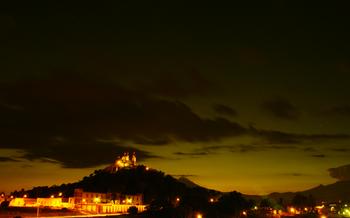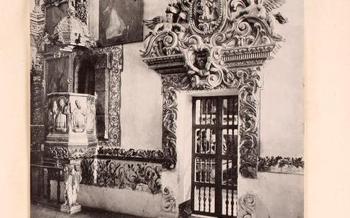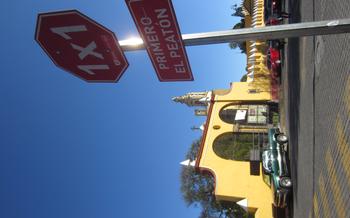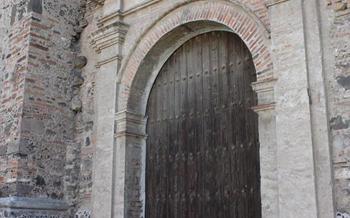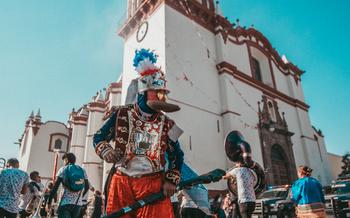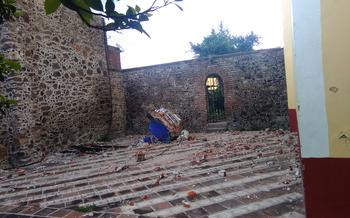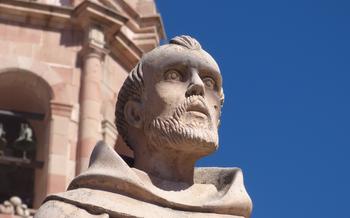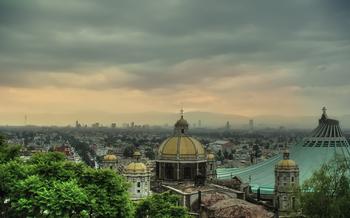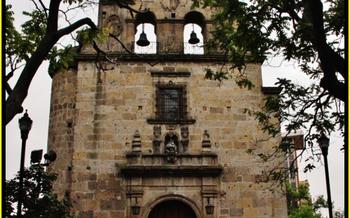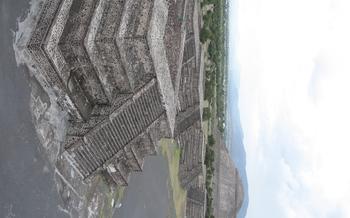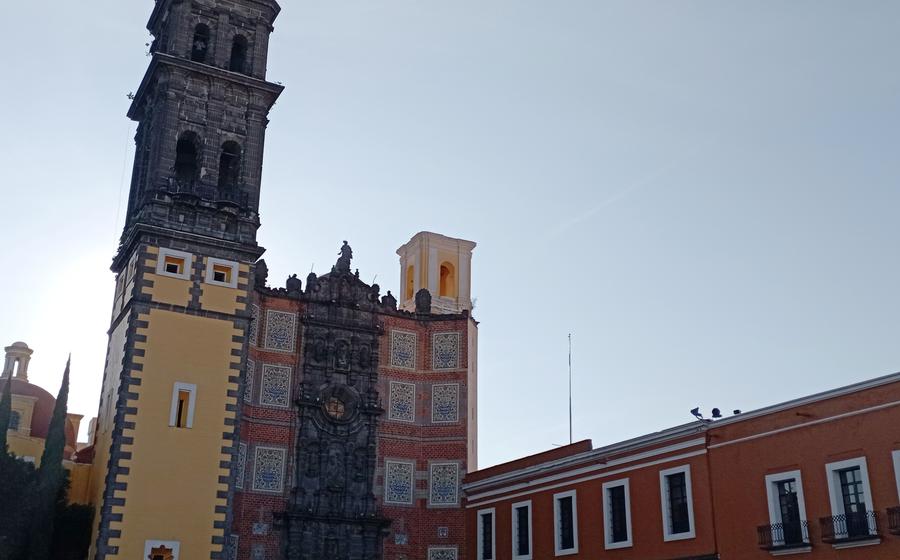
Templo de San Francisco
- Templo de San Francisco: A Baroque Masterpiece in Puebla
- Intricate Façade: A Symphony of Stone
- Majestic Towers: Reaching for the Heavens
- Captivating Altarpieces: A Feast for the Eyes
- Mystical Underground Passages: A Hidden Secret
- The Sacristy: A Treasure Trove of Sacred Artifacts
- Museo de Arte Religioso: A Journey Through Sacred Art
- The Chapel of the Virgin of Guadalupe: A Place of Pilgrimage
- The Courtyard: A Serene Oasis
- Festivals and Celebrations: A Vibrant Showcase of Culture
- The Neighborhood: Exploring the Historic Surroundings
- Tour Information: Practical Tips for Visitors
- Insider Tip: Discover the Hidden Murals
Templo de San Francisco: A Baroque Masterpiece in Puebla
The Templo de the artistry of the Baroque period, stands as a beacon of faith and history. Constructed in the 16th century by the Franciscan order, this magnificent edifice has borne witness to centuries of devotion, artistic expression, and the intertwining of indigenous and European influences that have shaped the cultural tapestry of Mexico. As one of the most significant religious structures in the city, the Templo de San Francisco invites visitors to embark on a journey through time, immersing themselves in the grandeur of its architecture, the intricate details of its ornamentation, and the profound spiritual significance it holds for the people of Puebla.
Intricate Façade: A Symphony of Stone
The Templo de San Francisco's façade is a masterpiece of Baroque architecture, adorned with intricate carvings and sculptures that narrate biblical stories and symbolize the triumph of faith. The finely detailed reliefs depict angels, saints, and scenes from the life of Jesus Christ, each with its own unique symbolism. The influence of indigenous artisans is evident in the incorporation of pre-Hispanic motifs and iconography, blending seamlessly with the European Baroque style.
The façade's central portal features an elaborate archway framed by twisted columns and surmounted by a triangular pediment. Within the arch, the tympanum showcases a sculpture of the Virgin Mary surrounded by cherubs, while the archivolt is adorned with intricate carvings of flowers, fruits, and mythical creatures. The two side portals mirror the central one, each with its own unique decorative elements.
The façade's crowning glory is the pair of bell towers, which rise majestically on either side. Their slender spires, adorned with intricate carvings and topped with weather vanes, pierce the sky, creating a dramatic silhouette against the backdrop of the city.
Majestic Towers: Reaching for the Heavens
The Templo de San Francisco boasts two imposing towers that rise proudly towards the sky, each reaching a height of approximately 70 meters. These towers are not just architectural marvels but also offer breathtaking views of the city and the surrounding landscapes. Visitors can ascend the towers to experience the panoramic vistas and witness the grandeur of Puebla from above. The bell towers house a set of bells that chime melodiously, creating a symphony of sounds that reverberate through the neighborhood. The bells hold a significant place in the religious and cultural traditions of the city, marking important occasions and summoning the faithful to prayer.
Captivating Altarpieces: A Feast for the Eyes
The interior of the Templo de San Francisco is adorned with a series of captivating altarpieces that are considered masterpieces of Baroque art. Each altar is intricately carved and adorned with gold leaf, creating a dazzling display of opulence and artistry. The altarpieces depict various biblical scenes and symbols, showcasing the profound influence of Christianity on Mexican culture.
The main altar, dedicated to Saint Francis of Assisi, is the most elaborate and impressive of all. It features a towering structure with multiple tiers, each adorned with intricate carvings and sculptures. The central niche houses a life-sized statue of Saint Francis, surrounded by angels and cherubs. The altar is a testament to the skill and devotion of the indigenous artisans who created it, blending European Baroque influences with traditional Mexican motifs.
Other notable altarpieces include the Altar of the Virgin of Guadalupe, which features a beautiful statue of the Virgin Mary surrounded by roses and cherubs. The Altar of the Holy Family depicts the Holy Family with baby Jesus, Mary, and Joseph, while the Altar of the Crucifixion shows a dramatic representation of Jesus on the cross. These altarpieces, with their intricate details and symbolism, offer a glimpse into the rich religious traditions and artistic heritage of Mexico.
Mystical Underground Passages: A Hidden Secret
Beneath the grandeur of the Templo de San Francisco lies a hidden realm of mystical underground passages. These tunnels, constructed in the 17th century, once served as a secret escape route for the friars in times of danger. Today, they offer visitors a glimpse into the temple's intriguing past.
Exploring the underground labyrinth is like stepping back in time. The narrow, winding tunnels are lined with ancient stone walls and vaulted ceilings. The air is cool and damp, carrying the secrets of centuries past. As you navigate the maze-like corridors, you can almost feel the presence of the friars who once tread these paths.
Legends and myths surround the underground tunnels, adding to their allure. Some say that the tunnels connect to other churches and monasteries in the city, forming a secret network of passageways. Others claim that the tunnels lead to hidden chambers filled with treasures and artifacts. While these tales may be embellished, they speak to the mystique and fascination that surround this hidden world.
The Sacristy: A Treasure Trove of Sacred Artifacts
The sacristy of the Templo de San Francisco serves as a repository of sacred treasures, housing an exquisite collection of religious artifacts that hold immense historical significance and cultural value. These objects, meticulously preserved and displayed, offer a glimpse into the rich spiritual heritage of Puebla. Among the highlights of the sacristy are intricately crafted chalices, ornate monstrances adorned with precious stones, and elaborate vestments used in religious ceremonies.
The sacristy also boasts a collection of historical paintings and sculptures, each narrating a chapter in the religious history of the temple and the city. These artworks, created by skilled artisans, depict biblical scenes, portray saints and martyrs, and commemorate significant events in the Catholic faith. The sacristy serves not only as a place of storage but also as a gallery, showcasing the artistic and cultural heritage of the Templo de San Francisco.
Visitors to the sacristy are invited to explore the stories behind these sacred objects, gaining insights into the beliefs, rituals, and traditions that have shaped the religious landscape of Puebla. The sacristy stands as a testament to the enduring devotion and artistry that have flourished within the walls of this venerable temple.
Museo de Arte Religioso: A Journey Through Sacred Art
Within the hallowed walls of the Templo de San Francisco, visitors will find a treasure trove of sacred art housed in the Museo de Arte Religioso. This museum is a testament to the deep religious devotion and artistic prowess that have shaped Puebla's cultural heritage.
The diverse collection showcases an array of religious paintings, sculptures, and artifacts, each piece narrating a chapter in the history of Catholicism in Mexico. Visitors can trace the evolution of religious art from the early colonial period to the present day, witnessing the fusion of European and indigenous artistic traditions.
Historical context and significance accompany each exhibit, providing visitors with a deeper understanding of the role that religion has played in shaping the social and cultural fabric of Puebla. The museum's collection serves as a testament to the enduring faith and artistic spirit of the Mexican people.
The Chapel of the Virgin of Guadalupe: A Place of Pilgrimage
Within the Templo de San Francisco, a sacred space holds a profound significance for the Mexican faithful: the Chapel of the Virgin of Guadalupe. This chapel is dedicated to the beloved patron saint of Mexico, whose image is deeply revered throughout the country. Pilgrims from all corners of Mexico and beyond flock to this sacred site to pay homage to the Virgin and seek her blessings.
The chapel's interior is adorned with intricate murals and artwork that depict the life and miracles of the Virgin of Guadalupe. The central altarpiece is a masterpiece of colonial art, featuring a resplendent statue of the Virgin surrounded by angels and saints. The walls of the chapel are adorned with colorful tiles, each narrating a chapter from the Virgin's story.
Pilgrims come to the chapel to pray, light candles, and leave offerings to the Virgin. Many believe that the Virgin of Guadalupe has the power to perform miracles and grant favors to those who seek her intercession. The chapel is particularly crowded during the Virgin's feast day on December 12th, when thousands of pilgrims gather to celebrate her apparition.
Visiting the Chapel of the Virgin of Guadalupe is a deeply moving experience, offering a glimpse into the profound faith and devotion of the Mexican people. Whether you are a pilgrim or simply a curious traveler, the chapel's aura of spirituality and reverence is sure to leave a lasting impression.
The Courtyard: A Serene Oasis
Amidst the grandeur and opulence courtyard. Step into this serene sanctuary, where lush greenery and intricate architectural details create an atmosphere of peace and tranquility.
The courtyard, with its manicured gardens and vibrant flowers, offers a stark contrast to the ornate interior of the temple. Here, visitors can find respite from the bustling city streets and immerse themselves in a moment of contemplation or relaxation.
Surrounding the courtyard are elegant arcades supported by slender columns, creating a sense of symmetry and harmony. Intricate carvings adorn the arches, showcasing the artistic prowess of the indigenous craftsmen who contributed to the temple's construction.
In the center of the courtyard, a magnificent fountain stands as a testament to the ingenuity of the temple's builders. Water cascades gently from the fountain's tiers, creating a soothing melody that echoes through the serene space.
The courtyard is a perfect spot to take a break from exploring the temple's many wonders. Sit on one of the benches beneath the shade of a towering tree and soak in the tranquil atmosphere, allowing the beauty of this hidden gem to wash over you.
Festivals and Celebrations: A Vibrant Showcase of Culture
The Templo de San Francisco is not only a religious and historical site but also a vibrant center for cultural events and celebrations. Throughout the year, the temple hosts a variety of traditional festivals and events that showcase the rich cultural heritage of Puebla.
One of the most significant celebrations is the annual feast of Saint Francis of Assisi, the patron saint of the temple. Held in early October, the festival features processions, traditional dances, music performances, and a lively fair with food, crafts, and games.
Another highlight is the Day of the Dead (Día de los Muertos), celebrated in early November. The temple becomes a place of remembrance and celebration as families gather to honor their deceased loved ones. Altars adorned with candles, flowers, and offerings are set up inside the temple, and special masses are held to commemorate the departed.
These festivals and events offer visitors a unique opportunity to immerse themselves in the local culture and traditions of Puebla. By participating in these celebrations, visitors can experience the vibrant energy and hospitality of the city's people.
The Neighborhood: Exploring the Historic Surroundings
Beyond the grandeur of the Templo de San Francisco lies the equally captivating neighborhood that surrounds it. Take a leisurely stroll through the charming streets and admire the colonial architecture that lines every corner. The buildings here tell tales of a rich past, with intricate facades and colorful tiles adorning their exteriors.
Immerse yourself in the vibrant culture of Puebla as you visit local markets and shops, where you can find traditional handicrafts, souvenirs, and delectable local cuisine. Sample the flavors of Puebla's renowned gastronomy at one of the many restaurants in the area, savoring the unique blend of indigenous and Spanish influences that define the city's culinary scene.
Engage with the friendly locals, who are always eager to share stories about their beloved city. Learn about their customs, traditions, and the significance of the Templo de San Francisco in their daily lives. Whether you're seeking a bite to eat, a unique souvenir, or simply a glimpse into the everyday life of Puebla, the neighborhood surrounding the temple offers a rich tapestry of experiences.
Tour Information: Practical Tips for Visitors
Guided Tours and Self-Guided Exploration
To delve deeper into the history and significance of the Templo de San Francisco, guided tours are highly recommended. Knowledgeable guides provide insightful commentary, unveiling the stories and symbolism behind the intricate details of the temple. Visitors can also opt for self-guided exploration, allowing them to wander at their own pace and capture the beauty of the temple through photography.
Hours of Operation and Admission Fees
The Templo de San Francisco welcomes visitors daily, offering ample time to explore its grandeur. The hours of operation typically range from 9:00 AM to 6:00 PM, with variations possible during certain holidays or events. A modest admission fee is required, contributing to the preservation and maintenance of this architectural masterpiece.
Accessibility for Visitors with Disabilities
The Templo de San Francisco strives to provide an inclusive experience for all visitors. Accessible entrances and ramps allow individuals with disabilities to navigate the temple with ease. The staff is also accommodating, offering assistance wherever necessary to ensure a comfortable and enjoyable visit.
Insider Tip: Discover the Hidden Murals
Beyond the main attractions, Templo de San Francisco holds secret treasures waiting to be discovered. In the depths of the underground passages, intricate murals adorn the walls, telling stories and depicting scenes from the Bible. These hidden gems, often overlooked by visitors, offer a glimpse into the artistic heritage of the temple.
To uncover these secret murals, explore the lesser-known areas of the temple, venturing into the underground labyrinth. With a keen eye, you'll find these hidden masterpieces, each with its own unique story to tell.
Discover the hidden murals of Templo de San Francisco and immerse yourself in the rich artistic tapestry that adorns this historic landmark. These hidden treasures await those who seek them, offering a deeper connection to the temple's history and cultural significance.
